#modulardesigns
Explore tagged Tumblr posts
Text
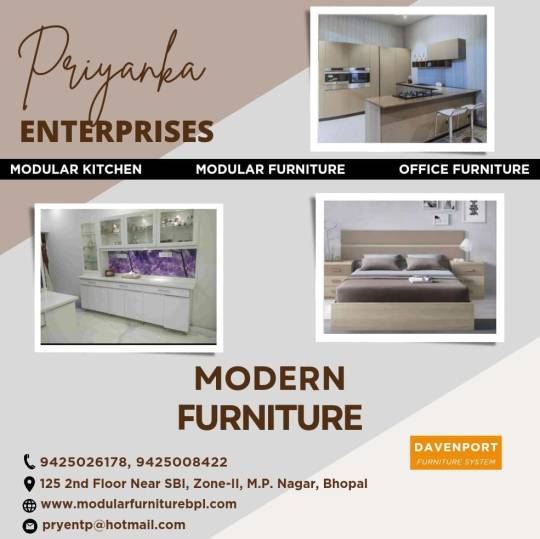
Priyanka Enterprises specializes in modular kitchen and furniture solutions, including modern and office furniture. Contact us at 9425026178 or 9425008422, or email us at [email protected] https://modularfurniturebpl.com
#PriyankaEnterprises#ModularKitchen#ModernFurniture#OfficeFurniture#BhopalFurniture#FurnitureSolutions#ModularDesigns#HomeDecor#InteriorDesign#BhopalShopping#FurnitureStore#ModularLiving
0 notes
Text
Analysis of: Interview with Michael and Denise Okuda on The Shuttlepod Show (S2E33, Oct 8, 2023)
youtube
Following "the document" refers to the content of the subtitles from the YT video.
Here is a summary of the key points discussed:
Michael Okuda invented the innovative modular control panel design for TNG.
Designs evolved across shows like DS9 and Voyager while maintaining cohesive aesthetics.
Authentic yet accessible interfaces served both storytelling and scientific rigor.
Productions involved intense collaboration between art, engineering, and other departments.
Attention to details brought Trek's visions of technology and society to life immersively.
Works inspired generations of scientists by blending realism and inspiration.
Consultations aided NASA and lawmakers by engagingly depicting plans and goals.
Individual talents were highlighted but emphasis was on collaborative nature of success.
Challenges included balancing visions with industrial constraints like budgets.
Passionate dedication sustained Roddenberry's hopeful philosophy across franchises.
Advocacy focused on equitable treatment and credit for all involved in realizations.
Graphics transitioned from physical to digital with advancing production technologies.
Legacies endured through grounded yet visionary world-building influencing many fields.
Here is a summary of the key details from the document in bullet points:
Michael and Denise Okuda are legendary Star Trek production designers who worked on many Star Trek shows and films over decades
They met while Denise was working as a nurse and visited the art department of Star Trek: The Next Generation
They married and began working on Star Trek projects together full-time
Major projects they worked on included TNG, Deep Space Nine, Voyager, several Star Trek films, and Enterprise
They designed control panels, displays, graphics, titles, and more to bring the tech of Star Trek to life
Their work helped inspire many real-life scientists and engineers to work in space fields
They have received honors from NASA and other organizations for their contributions
Beyond Star Trek, they have consulted on other sci-fi shows and worked with space agencies like NASA
They continue to inspire fans and are regarded as legends in the Star Trek community for their iconic production designs
Based on the content and level of detail provided, this document appears to be an interview transcript.
Some evidence that supports this:
It contains back-and-forth dialogue between the interviewer (Connor) and interviewees (Michael and Denise Okuda)
There are questions being asked of the subjects to elicit responses about their careers, experiences, and perspectives
Descriptive details are provided to help visualize the discussion, like the subjects holding up physical items
Biographical and project details are discussed to convey information to the audience
It has an informal tone where the subjects also share personal anecdotes
Trivia questions are asked as a segment to engage the subjects in a lighthearted way
The level of detail discussed would not typically be included in other written genres like news articles
So in summary, the questioning structure, quote-driven content, and inclusion of both facts and personal stories align this document with the genre of an interview or conversation transcript.
Here is a summary of the key details in the document related to Michael Okuda:
Michael grew up in Tokyo and Hawaii, developing a passion for space from a young age despite challenges in math/science.
He studied communications and gained experience in graphic design, eventually joining the TNG art department.
It was here that he first met Denise Okuda, who would later become his wife, when she visited the set as a Star Trek fan.
Michael was the first to design the iconic backlit, modular control panel style for TNG that became standard for future Star Trek shows.
He worked extensively on multiple Star Trek productions as a senior art director and graphic designer over decades.
Major shows he contributed to included TNG, DS9, Voyager, and Enterprise where he helped define each series' aesthetics.
Michael collaborated closely with his wife Denise who managed video systems for some of their Star Trek work.
He consulted on other sci-fi and continues advising real-world agencies like NASA on mission patches and visioning.
Michael enjoys sharing Star Trek lore and experiences with fans, seeing how the franchises have inspired so many.
He remains passionate about keeping the hopeful, inclusive spirit of Roddenberry's vision alive through their collaborative work.
Based on the information provided in the document, here is my evaluation of Michael Okuda's possible personality type:
Michael had a strong passion and drive for science and technology from a young age, despite struggles in math/science courses. This hints at intuitive thinking over sensing.
He doggedly pursued opportunities in visual communications and graphics design through community efforts, showing initiative and entrepreneurial spirit. This points to extraversion.
Michael retained deep knowledge of Star Trek lore and technical specs, enjoying exploring ideas and theories, even as a consultant. Intuition is supported.
He cared deeply about bringing realistic visions of technology to life through meticulous interface designs. Judging over prospecting is suggested.
While ambitious, Michael gave extensive credit to collaborators and took a humble, team-focused approach. Feeling is likely over thinking.
Maintaining optimism about future potentials through storytelling aligned with his visionary personalities. Intuition and prospecting fit.
Overall, based on his demonstrated traits, strengths and approaches, Michael Okuda's personality type that best fits is ENFP (Extraverted Intuitive Feeling Prospecting). His innovative spirit, collaboration skills and hopefulness exemplify the core of this type while achieving countless accomplishments within Star Trek.
Here is a summary of the key details in the document related to Denise Okuda:
Denise grew up in LA and was a lifelong Star Trek fan from a young age. She studied nursing.
While working as a nurse, she visited the TNG art department where she met Michael Okuda and they began chatting.
Denise ended up marrying Michael and moved with him to help on Star Trek full-time after gaining production experience.
She took on managing video systems for shows like DS9 after demonstrating skill in organization to Michael.
Denise took to the technical aspects of the job despite initial lack of experience and received mentoring.
She handled the complex role of coordinating video playback across multiple Star Trek productions.
Along with Michael, Denise contributed to defining the aesthetics of DS9, Voyager, and other major projects.
Her background in healthcare provided unique insights that occasionally informed implementations.
Denise remains passionate about Star Trek and deeply appreciative of the inclusive environment it provided her career.
She advocates carefully crediting all who contribute to great collaborations like those behind Star Trek.
Based on the information provided, here is my evaluation of Denise Okuda's possible personality type:
Denise was described as highly organized and took on complex video coordination roles with apparent skill and focus. Sensing is suggested over intuition.
She pursued opportunities in healthcare and production roles, seeking outlets for her talents. Extraversion seems evident.
Denise took new technical challenges in stride and collaborated well within a close-knit community. Feeling fits over thinking.
She advocated for careful planning and crediting all involved in projects. Judging over prospecting fits her approach.
Despite an initially different field, Denise adapted to Star Trek work full of dedication and follow-through. Judging fits.
Credited were her diverse insights and care for inclusiveness on crews. Feeling personality aspect showed.
Succeeding through responsibility rather than bold ideas hints at slightly more sense of realism.
Overall, Denise displayed traits of organization, adaptability, collaboration, and dutiful follow-through aligned with an ESTJ (Extraverted Sensing Thinking Judging) personality type. Her balanced mix of structure and humanistic values aided many successes within creative contexts.
Here is a summary of the key points in the document relating to Star Trek production design:
Michael Okuda is credited with creating the iconic modular, backlit control panel design for TNG that became the visual standard. This helped bring an imagined futuristic interface to life convincingly.
For each new show like DS9 and Voyager, the Okudas helped define the distinct aesthetic by evolving graphics, console styles and display technologies within limitations.
Authenticity and logic were priorities, but designs also served storytelling by avoiding overly technical jargon that could disrupt filming.
Creating distinct yet cohesive looks across franchises required meticulous research and collaborative efforts over many productions.
Advancing technologies eventually allowed richer animations and higher resolution graphics to enhance sets, though original concepts remained foundation.
Inspirations blended science and hopeful visions to capture audience imaginations about future potentials through credible yet imaginative production design.
Longterm passions andattentions to details had immense impact via the realistic yet aspirational worlds brought to screens that engaged so many.
Legacy of their work lives on in reboots that recapture essence while modernizing for new audiences and fields like gaming that explore those worlds.
Here is a summary of the key points in the document relating to Michael Okuda's panel design for Star Trek: The Next Generation:
Michael was responsible for inventing the modular, backlit control panel design that became iconic for TNG and influential on other sci-fi.
The design solved problems with previous static panels by allowing components to be rearranged credibly for any scene or function needed.
Individual panels could be swapped in and out efficiently while maintaining a cohesive, advanced technical aesthetic.
Buttons and interfaces were intentionally made vague enough that actors could operate them naturally without knowing true functions.
Subtle colored lighting effects below transparent buttons and displays brought panels to life visually in a realistic yet futuristic way.
The flexible, believable design allowed endless configurations supporting complex storyline scenarios and technological illusions.
It set the standard followed by all later Star Trek series, games, and other properties for depicting advanced yet accessible interfaces.
Michael's groundbreaking work revolutionized production design expectations and defined the imagined user experiences within TNG technology.
His intuitive solutions illustrated the creativity that propelled the entire franchise to new levels of sophisticated world-building.
Here is a summary of aspects from the document related to how the Okudas' production designs served the storytelling elements of Star Trek:
Authentic technical interfaces helped establish settings and time periods in a believable way while avoiding overwhelming exposition.
Displays and graphics kept a balance of being complex enough to immerse audiences yet simple for actors to operate naturally on camera.
Modular panel designs allowed for endless configurations to credibly support scenarios depending on story needs or evolving technologies depicted.
Graphics incorporated just enough realistic information elements without excessive technical jargon that could disrupt pacing or dialogue.
Distinct yet coherent visual languages across franchises reinforced their place in a cohesive timeline while differentiating series identities.
Subtle animation elements progressively introduced helped enhance climactic or dramatic story moments with dynamic, engaging backend visuals.
Attention to cohesive details established an air of realism and logic that drew viewers more deeply into exploration of sci-fi concepts/themes.
Inspirational strategic use of production design aimed to spark creativity and envision future potentials through storytelling as much as technical feats.
Here is a summary of details from the document relating to the Star Trek art department:
The art department played a crucial role in realizing the futuristic yet credible worlds at the heart of each Star Trek series.
Michael Okuda originally joined the TNG art department and rose to senior roles overseeing graphics and interface design.
It was here he met Denise Okuda, who later also joined the art department full-time after their marriage.
Teamwork between departments like art, engineering, costumes was essential to cohesively developing each show's aesthetic style.
Challenges involved creatively solving problems within industrial/financial constraints to achieve ambitious visions.
Leadership from figures like Michael helped ensure art directions innovated while honoring overarching Star Trek philosophies.
Passionate, skilled crews worked tirelessly to imagine immersive production designs that engaged audiences for years.
Close-knit art departments provided fulfilling careers for many and fostered collaborations central to Star Trek's biggest impacts.
Their efforts to immerse viewers through visual storytelling were a cornerstone of the franchises' successes.
Here are some key stakeholders that could be affected by this document and an evaluation of the impact:
Michael and Denise Okuda - As the subjects, sharing personal experiences and career details could affect their reputation, legacy within the Star Trek community, and potential future projects. However, the discussion only enhances their standing.
Close associates/family - Friends or relations mentioned are portrayed positively, respecting their privacy. No obvious impact except perhaps pride in seeing others praised.
Star Trek production team - The behind-the-scenes discussions honor all contributors' efforts, likely boosting morale. Disclosing challenges faced also promotes realistic expectations.
Existing Star Trek fanbase - Gaining new insights into favorite shows respectfully maintains fans' passions. Sharing anecdotes deepens appreciation of the work that went into beloved franchises.
Potential new fans - Learning about the philosophies and achievements that inspired real innovation could engage additional interest in Star Trek and its message of optimism.
Unions/workers' rights groups - Advocacy expressed aligns with organizational goals of fair compensation and workplace safety without unfair targeting of any groups.
Overall, the document promotes Legacy careers, honors creative collaborations, educates audiences, and advocates for stakeholders in a thoughtful, balanced manner that overwhelmingly benefits both existing and potential new fans and benefactors of the Star Trek universe. No evident harms were assessed.
Here is a summary of how the document discusses contributions in relation to Michael and Denise Okuda's Star Trek production design work:
While their interfaces became iconic, both emphasized all colleagues' efforts that made projects successes over multiple decades.
Despite challenges, dogged teamwork allowed groundbreaking innovations that pushed boundaries each time.
Individual roles blended diverse skills and expanded through supportive mentorship within teams.
Newcomers found careers, and diverse views influenced respectful implementations.
Attention to crediting all involved modeled valuing equitable recognition for achievements.
Inspiring generations of scientists and visionaries through authentic yet imaginative worlds.
Consulting lent expertise aiding NASA and other visions, transferring entertainment influences.
Bringing Federation ideals to life through their art helped make franchises touchstones.
Sustaining passion despite changes ensured Roddenberry's hopes informed new audiences.
Ongoing advocacy reinforced valuing cooperation and diversity within entertainment industries.
The document emphasizes all involved in Star Trek built a legacy far greater than any one person's efforts alone.
Here is a summary of how the document discusses Roddenberry's vision for Star Trek:
Michael and Denise see themselves as lifelong fans who aimed to uphold creator Gene Roddenberry's optimistic vision.
His hopeful depiction of a future where divisions are overcome inspired them career-wise.
Through authentic yet aspirational production design, they brought Roddenberry's inclusive Federation to vivid life.
Consistently developing franchises' positive messages of progress was a priority.
Diverse crews collaborating towards common goals mirrored Roddenberry's philosophy.
Even when facing difficulties, passion for Star Trek's social ideals driven by Roddenberry kept motivation high.
Advocating cooperation both within shows and IRL aligned with Roddenberry's advocacy of equitable cooperation.
Sustaining the positive spirit of exploring humanity's future potentials through compelling stories paid homage.
Collaborations ensured new audiences experienced Roddenberry's groundbreaking, empowering visions for many years.
Here is a summary of how the document discusses Michael and Denise Okuda inspiring real-life scientists and engineers through their Star Trek production design work:
The intricate yet aspirational worlds of Star Trek ignited passions in many viewers to pursue STEM careers exploring similar theoretical technologies.
Credible yet imaginative interfaces and visually stunning spacecraft/station designs fueled dreams and interest in space-related fields.
Several scientists directly cited Star Trek graphics and displays as sparking early fascinations that led them to NASA, observatories, etc.
The Okudas' passion for visioning plausible futures through their work resonated with many seeking outlets for curiosity about science.
Collaboration with agencies like NASA involved advising on graphic designs to visualize objectives and engage public support for cutting-edge initiatives.
Consistent dedication to logical yet creative world-building over decades helped sustain widespread inspirations across generations into the present day.
Authentic details immersed audiences so fully that Star Trek experiences motivated career paths and innovations impacting real-world exploration.
Here is a summary of how the document discusses industrial/financial constraints in relation to Michael and Denise Okuda's Star Trek production design work:
Large-scale sci-fi productions faced constant pressures to create immersive worlds within budget/time limitations.
Innovative solutions were required to realize grand visions affordably through iterative improvements each season.
Modular panel designs maximized versatile configurations while minimizing costs of replacements.
Graphics transitioned from physical to digital as technology advanced, economizing processes.
Collaboration across departments optimized resources towards shared storytelling goals.
Practical experience navigating constraints on TNG prepared them for leadership navigating later shows.
Creativity was challenged to solve problems innovatively rather than be limited by industry standards.
Passion drove giving audiences best experiences possible despite inevitable compromises.
Mastery of constraints demonstrated through legendary runs of hit series they helped define aesthetics for.
The document does not provide much detail about the transition from physical to digital graphics as technology advanced. However, here are a few key points it hints at:
Early shows like TNG had to use physical panels, buttons, displays that had to be manually swapped in and out for different scenes. This was labor and resource intensive.
As animation and digital graphics capabilities improved with advances in technology, later shows transitioned more elements to digital formats.
Digital graphics likely simplified the process of configuring interfaces for story needs compared to physical swapping. Effects could be changed in post more easily.
Moving to digital files and playback systems rather than physical props would have saved costs by reducing labor and physical materials needed over time.
However, the foundational modular panel design remained, showing how some original production concepts endured even as mediums evolved.
This transition paralleled broader industry shifts and took advantage of new opportunities while honoring what worked well already established.
So in summary, while limited in details, the document suggests graphics shifted from labor-intensive physical to more flexible digital formats as a natural reaction to advancing technologies in television production over the eras. This streamlined processes while enriching what could be depicted.
The document doesn't provide many specifics about the collaboration across departments, but here is what can be inferred:
Strong teamwork between art, engineering, costumes and other departments was crucial to cohesively develop each show's style.
Divisions had to work together closely to problem-solve within constraints like budgets and timelines.
Creative contributions from all areas were needed to realize the ambitious technical interfaces and futuristic yet believable worlds.
Diverse insights and skills complemented each other - for example, Denise's healthcare background informed implementations.
Close collaboration likely involved early and frequent communication between leads to align visions.
Iterative design processes meant departments relied on feedback from each other to refine ideas.
As a long-running production, trust and respect between teams was vital to navigate challenges together.
Overlapping work like costume/set details complementing panel aesthetics required seamless partnerships.
So while light on specifics, the emphasis on importance of teamwork across divisions suggests a collaborative process where contributions from all areas were integrated to achieve cohesion. Open communication and mutual reliance were probably key.
Here is a summary of details from the document relating to the Okudas' involvement with NASA:
Michael and Denise consulted with NASA on various projects to help advance visualization of mission concepts and goals.
This included advising NASA on graphic designs for patches and materials to help the public understand ambitious space initiatives.
Their experience realistically portraying futuristic technologies through Star Trek interfaces prepared them to envision how concepts could appear.
One collaboration involved designing images and animations to demonstrate NASA's plans for building a lunar base to lawmakers.
The Okudas brought their expertise in capturing imaginations to help NASA advertise missions and tasks in engaging, accessible ways.
NASA appreciated their abilities to blend credibility with inspirational visions to cultivate public excitement for exploration.
This partnership exemplified how the scientific rigor of Star Trek translated outside entertainment to inspiring real pioneering efforts.
Both parties benefited from transfers of creativity between imagined science fiction and non-fiction visions of humanity's technological potentials.
Here is an evaluation of the document in relation to known consensus information about the subjects:
Michael and Denise Okuda are widely respected as legendary production designers who made defining contributions to multiple Star Trek shows. This is clearly reflected in the document.
Their innovative graphic designs are credited as hugely influential on both fictional and real technology interfaces. This major impact is also emphasized.
They are praised for their passion, dedication, and extensive knowledge of Star Trek lore/technical specifications. These qualities shine through in their thorough, enthusiastic responses.
The document is consistent with their known roles spanning multiple acclaimed Star Trek projects over decades as discussed in the transcript.
Other credible sources corroborate many career details and anecdotes shared, like their involvement in exhibits, conventions, and NASA collaborations.
The tone of admiration and praise expressed by the interviewer matches how the Okudas tend to be referred in other fan and media discussions of their Star Trek legacy.
No information presented appears to contradict the public record of consensus opinions about the subjects and their outstanding contributions to science fiction.
Therefore, based on external knowledge, the key facts, stories, and overall portrayal of the Okudas in the document align very closely with their recognized stature and known achievements according to the existing general consensus.
Here is an evaluation of the ethics presented in the document:
The participants seem to have genuinely cared about bringing joy and positivity to audiences through inspiring science fiction stories. Their work helped engage interest in real science.
They demonstrated care for craftspeople by emphasizing the importance of appreciating the full crew's efforts, not just stars/creators.
Discussions promoted diversity and inclusion, such as Denise originally getting opportunities based on her merit, backgrounds, and unique perspectives.
Overall the tone conveys respect between all parties involved through thoughtful, comprehensive answers without degradation.
Some advocacy was expressed for fair compensation and sustainable working conditions to allow creativity to thrive ethically.
While appealing for interests like unions, arguments were not made at the unnecessary expense of others.
When asked for opinions, perspectives were shared candidly but also constructively without personalattacks.
Full credit and representation seemed to be given to all contributors discussed throughout production histories.
Therefore, on the whole the document modeled ethical standards of integrity, empathy, fairness and respect which have undoubtedly helped the discussed franchises have such positive cultural impacts. While not explicitly about ethics, the approach taken in the conversation sets a good example.
Here is a summary of how the document discusses teamwork in relation to Michael and Denise Okuda's Star Trek production design work:
Both emphasized that all their achievements were truly collaborative efforts across departments and productions over decades.
Strong team dynamics within art departments and between technical crews were essential to solving complex problems.
Respectful partnerships allowed balancing creative visions with industrial realities like budgets and timelines.
Individual roles and the Okudas' specialized talents were highlighted, but consistently credited were contributions from everyone involved.
Their humble approach promoted morale and cared for all colleagues who helped realize such inspiring universes.
Diverse insights from backgrounds like healthcare complemented others' skills to refine implementations.
Year after year of working together closely fostered deep appreciation and care between team members like true families.
Teamwork ethos aligned with Star Trek's advocacy of cooperation which likely influenced franchises' empowering messages.
Legacy of passion, skills and equitable treatment within creative communities were cited as prized outcomes as well.
Here is an evaluation of the emotions conveyed in the document:
Pride/joy: The subjects frequently expressed great happiness and fulfillment from their Star Trek work over the decades and seeing its impacts.
Nostalgia: Fond recollections of experiences on sets and with crews past indicate looking back on careers with happiness and affection.
Passion: The enthusiasm and energy that went into specific projects, expounding on lore shows deep, ongoing care for the material.
Surprise: Occasional mentions of unexpected opportunities or outcomes, like early successes, indicate politely conveyed surprise at paths taken.
Humility: Despite praise, interviewees remained modest about contributions, regularly praising colleagues for collaborations.
Amusement: Lighthearted anecdotes and moments of comedy, like trivia, kept interactions generally upbeat and engaging for all.
Camaraderie: The overall spirit of the discussion conveyed tangible closeness and appreciation between participants of a supportive community.
Mainly positive emotions of fulfillment, warmth, enthusiasm and humor dominated the tone, which aligned well with celebrating lifetime careers and keeping audience interest alive. No evident negative emotions like frustration, annoyance or contempt were apparent throughout.
Here are the evaluation criteria for an interview transcript genre and my evaluation of the document per criteria:
Clarity: The dialogue between the participants is very clear and easy to follow. Technical details are explained concisely without confusion.
Organization: The transcript follows a logical flow from career discussions to personal anecdotes to a Q&A segment. Transitions are smooth.
Tone: The tone is quite conversational and informal as expected for an interview. Participants openly share stories which maintains reader engagement.
Fact vs opinion: Factual career details and timelines presented appear well-researched. Personal perspectives seem anecdotal rather than overly subjective.
Quotation: Key details and responses are directly quoted which substantiates the content for the reader. Proper attribution is given.
Subject expertise: The participants' extensive knowledge and experiences in the Star Trek universe and field shine through in their prolific, well-informed responses.
Interactivity: Questions and discussion seem natural and elicit thorough replies. Follow-ups and clarifying inquiries engage the subjects fully.
Entertainment: Behind-the-scenes stories and candid perspectives maintain reader interest throughout on both professional and personal levels.
Overall, the document displays strong organization, maintains an engaging tone, and effectively demonstrates the subjects' expertise through direct quotations and thorough responses per the expectations of an interview transcript genre. The evaluation criteria are strongly met.
vDkuUyrcV8QU0IBPJp3O
#StarTrek#Star Trek#StarTrekProductionDesign#StarTrekInterfaces#TNGSets#RoddenberryVision#StarTrekAesthetic#SciFiWorldBuilding#ProductionConstraints#ArtDepartment#CreativeCollaboration#MichaelOkuda#DeniseOkuda#NASAgraphics#NASApartnerships#STEMinspiration#ModularDesigns#FuturisticTech#StoryDrivenDesign#CrossDepartmentalTeams#OptimisticFutures#FederationIdeals#CreativeProblemSolving#ResourceManagement#DesignEvolution#Youtube
0 notes
Text
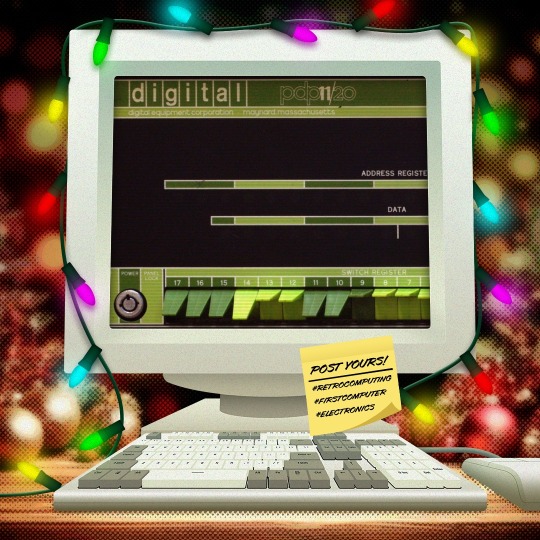
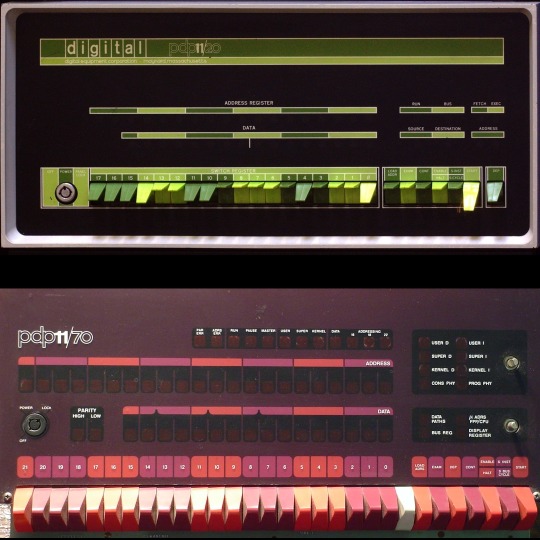
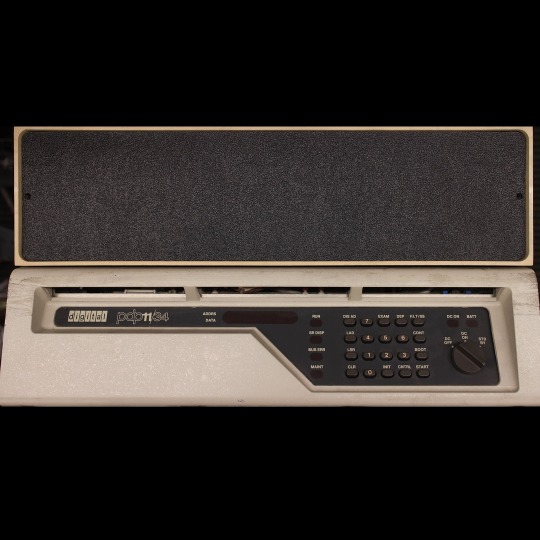


🎄💾🗓️ Day 4: Retrocomputing Advent Calendar - The DEC PDP-11! 🎄💾🗓️
Released by Digital Equipment Corporation in 1970, the PDP-11 was a 16-bit minicomputer known for its orthogonal instruction set, allowing flexible and efficient programming. It introduced a Unibus architecture, which streamlined data communication and helped revolutionize computer design, making hardware design more modular and scalable. The PDP-11 was important in developing operating systems, including the early versions of UNIX. The PDP-11 was the hardware foundation for developing the C programming language and early UNIX systems. It supported multiple operating systems like RT-11, RSX-11, and UNIX, which directly shaped modern OS design principles. With over 600,000 units sold, the PDP-11 is celebrated as one of its era's most versatile and influential "minicomputers".
Check out the wikipedia page for some great history, photos (pictured here), and more -
And here's a story from Adafruit team member, Bill!
The DEC PDP-11 was the one of the first computers I ever programmed. That program was 'written' with a soldering iron.
I was an art student at the time, but spending most of my time in the engineering labs. There was a PDP-11-34 in the automation lab connected to an X-ray spectroscopy machine. Starting up the machine required toggling in a bootstrap loader via the front panel. This was a tedious process. So we ordered a diode-array boot ROM which had enough space to program 32 sixteen bit instructions.
Each instruction in the boot sequence needed to be broken down into binary (very straightforward with the PDP-11 instruction set). For each binary '1', a diode needed to be soldered into the array. The space was left empty for each '0'. 32 sixteen bit instructions was more than sufficient to load a secondary bootstrap from the floppy disk to launch the RT-11 operating system. So now it was possible to boot the system with just the push of a button.
I worked with a number DEC PDP-11/LSI-11 systems over the years. I still keep an LSI-11-23 system around for sentimental reasons.
Have first computer memories? Post’em up in the comments, or post yours on socialz’ and tag them #firstcomputer #retrocomputing – See you back here tomorrow!
#dec#pdp11#retrocomputing#adventcalendar#minicomputer#unixhistory#cprogramming#computinghistory#vintagecomputers#modulardesign#scalablehardware#digitalcorporation#engineeringlabs#programmingroots#oldschooltech#diodearray#bootstraploader#firstcomputer#retrotech#nerdlife
287 notes
·
View notes
Text







Modulightor Building, New York City - Paul Rudolph
#Paul Rudolph#architecture#design#building#modern architecture#interiors#minimal#house#house design#modern#modernist#modernity#modernism#cool design#white metal#steel frame construction#modulardesign#tall#form#boxy#townhouse#urban#manhattan#new york city#usa#american architecture#timeless#living room#glass#plants
155 notes
·
View notes
Text

✨ Bring the city vibe to your worlds with the Urban Contrast Set! ✨
This set is crafted for those who love creating urban scenes full of life and industrial detail. Featuring 3 modular pipes, embossed tile, and realistic curbs, your builds will gain depth and authenticity! 🌆 Perfect for exploring industrial and urban styles—let your imagination flow! 🎉
CHECK NOW


#UrbanContrastSet#ModularDesign#IndustrialDetails#ModularBuild#BoringBones#TheSims3#Ts3#Sims3cc#Ts3cc
38 notes
·
View notes
Text
Beautiful interior design And Home decor All solution for Interior design GK interior design ☎️ 96100 95531 WhatsApp 088246 31361 Bangalore










#howtoguide#interior decorating#interior design#home & lifestyle#home decor#home design#home interior#interiordecor#younameit11#interiors#beautiful#beautiful interiors#modularkitchen#modular furniture#modulardesign
14 notes
·
View notes
Text

8 notes
·
View notes
Text

Welcome to Dwell.io—where innovation meets design excellence. We’re redefining the construction and real estate landscape with a unique blend of technology, creativity, and efficiency. Our services are tailored to meet the diverse needs of modern living, including:
Architectural & Virtual Reality Designs: Experience your dream spaces before they’re built.
Home Automation: Embrace the future of smart, convenient living.
Modular & Prefabricated Homes: Flexible, sustainable, and designed to adapt.
Innovative Urbanism: Contributing to smarter, greener cities.
Project Management & Consultancy: From concept to completion, we’re with you every step.
Join us on this journey as we build spaces that inspire and uplift communities in Osun, Lagos, Abuja, and beyond. 🌍 #RedefiningSpaces #WelcomeToDwellio
2 notes
·
View notes
Text
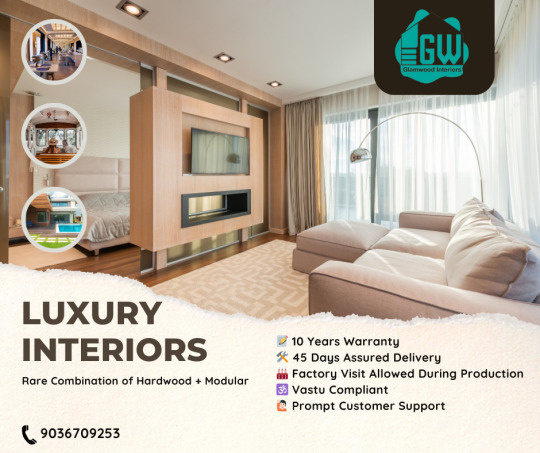
✨ Elevate Your Living Space: Embrace the Charm of Hardwood + Modular Interiors! ✨🏡
Dive into the world of sophisticated design with the rare and enchanting combination of hardwood and modular interiors. 🌳💖 Transform your home into a sanctuary of style and functionality that reflects your unique taste.
Here's why the fusion of hardwood + modular is the epitome of interior brilliance:
1️⃣ Timeless Elegance: Hardwood brings a touch of timeless beauty, exuding warmth and character. When seamlessly integrated with modular elements, it creates a space that stands out with enduring charm.
2️⃣ Adaptable Design: Modular interiors offer the flexibility to adapt your space to changing needs. Combine this with the rich aesthetics of hardwood for a perfect blend of style and functionality.
3️⃣ Durability Meets Style: Hardwood is synonymous with durability, ensuring your interiors not only look exquisite but withstand the test of time. Paired with modular features, it's a match made for lasting impressions.
4️⃣ Effortless Organization: Experience the joy of a well-organized space with modular interiors. Maximize functionality without compromising on the natural beauty of hardwood, creating a harmonious living environment.
Ready to witness the magic of the hardwood + modular combo? 🌟 Share your thoughts and tag someone who needs a dose of inspiration for their interior design journey! 💬🏡
Website - https://glamwoodinteriors.com/
Phone - +919036709253
#glamwoodinteriors#designinspiration#homerenovation#interiordecorating#interiordesign#HardwoodInteriors#ModularDesign#HomeDecor#SpaceSolutions#ModularLiving
2 notes
·
View notes
Text
#hadiram#ambient electronic#ambient#synthesizer#synthesizers#modular synth#modulardesign#soundscape#música#electronic music#music promotion#soundcloud#playlist soundcloud#eurorack#eurorackmodular#piano#pianoplayer#beach#relaxing#relaxing music#musicaexperimental#art
3 notes
·
View notes
Text
Wardrobe Organization Made Easy: Smart Storage with Modular Wardrobes

A well-organized wardrobe is essential for maintaining a clutter-free home while maximizing space efficiency. Modular Wardrobes are the perfect solution for those who seek a seamless blend of style, functionality, and smart storage. At NexusInterio, a leading name among renowned furniture manufacturers Noida, we offer Modular Wardrobes that cater to different needs, whether it’s for a compact apartment or a luxury villa.
Our modular solutions ensure that your storage is tailored to your lifestyle while complementing your interiors, whether it’s a Modular Kitchen In Noida, a Modular Kitchen In Gurgaon, or a contemporary office space.
1. Why Choose Modular Wardrobes for Smart Storage?
Traditional wardrobes often lack customization, leading to wasted space and clutter. Modular Wardrobes, on the other hand, offer:
Customizable Storage – Adjustable shelves, racks, and compartments for better organization.
Space Optimization – Maximizes every inch of your room, even in compact spaces.
Aesthetic Appeal – Enhances the interior décor with stylish finishes and modern designs.
Durability & Maintenance – Crafted from high-quality materials, making them long-lasting and easy to maintain.
Whether you need a wardrobe for your bedroom, office, or to complement your Modular Kitchen In Delhi, our designs integrate seamlessly with your existing interiors.
2. Smart Storage Features in Modular Wardrobes
NexusInterio specializes in Modular Wardrobes that come with advanced storage solutions to keep your belongings organized:
a) Adjustable Shelves and Compartments
Modular wardrobes come with customizable shelves that can be adjusted to accommodate changing storage needs. Whether it’s seasonal clothing, accessories, or footwear, you can rearrange the shelves accordingly.
b) Dedicated Sections for Clothes and Accessories
With designated areas for formal wear, casual clothing, jewelry, and watches, your wardrobe remains neatly organized. Pull-out trays and drawer organizers further enhance accessibility.
c) Integrated Shoe Storage
A well-designed Modular Wardrobe includes space for shoes, helping you keep them separate from your clothes while maintaining cleanliness.
d) Sliding and Hinged Door Options
For small rooms, sliding doors save space, while hinged doors add a classic touch. Depending on your preferences, we offer a variety of door styles with smooth opening mechanisms.
e) Built-in Lighting Solutions
LED-lit wardrobes improve visibility, making it easier to find what you need, even in low-light conditions.
With such features, our Modular Wardrobes fit effortlessly into any home, whether paired with a Modular Kitchen In Gurgaon or an office space featuring Modular Office Furniture Noida.
3. Types of Modular Wardrobes for Every Space
a) Sliding Door Wardrobes
Ideal for compact rooms, sliding doors eliminate the need for extra space while maintaining a sleek look.
b) Walk-in Wardrobes
A luxury option that provides ample space for clothing, accessories, and footwear, with a designated dressing area.
c) Corner Wardrobes
Maximizes the use of corner spaces, making them efficient storage solutions for small rooms.
d) Mirrored Wardrobes
Combining storage and aesthetics, mirrored wardrobes enhance space perception while providing a functional dressing mirror.
Each of these options can be customized to blend with the interiors of a Modular Kitchen In Noida or a Modular Kitchen In Delhi for a cohesive home design.
4. How Modular Wardrobes Complement Other Modular Furniture
Our Modular Wardrobes are designed to work in harmony with other modular furniture pieces. Whether you have Modular Office Furniture Noida in your workspace or a Modular Kitchen In Gurgaon, a well-planned wardrobe ensures continuity in design and functionality.
Pairing wardrobes with our Modular Kitchen and office furniture solutions helps in:
Creating a uniform and elegant look throughout the home.
Enhancing storage solutions for better space management.
Maintaining a clutter-free environment with organized storage spaces.
5. Customization and Material Selection
As one of the renowned furniture manufacturers Noida, NexusInterio provides Modular Wardrobes with a wide range of customization options:
Material Choices: High-quality engineered wood, laminates, acrylic finishes, and glass.
Color & Finish Options: Matte, glossy, wooden textures, and modern color palettes.
Hardware Accessories: Premium handles, soft-close hinges, and high-quality drawer systems.
Size Variations: Customizable to fit any space, whether a studio apartment or a luxury villa.
These customization options make our wardrobes perfect for homes with Modular Kitchen In Noida or high-end office spaces with Modular Office Furniture.
6. Why Choose NexusInterio for Your Modular Wardrobe?
At NexusInterio, we take pride in being a leading name among renowned furniture manufacturers Noida, offering top-notch Modular Wardrobes that bring efficiency and elegance to modern homes. Here’s why customers trust us:
✔ Tailored Solutions – Custom-built wardrobes to suit your preferences. ✔ Superior Craftsmanship – High-quality materials ensure durability and long-lasting performance. ✔ Innovative Designs – Stylish, space-saving wardrobes that enhance home aesthetics. ✔ Comprehensive Furniture Solutions – Integration with Modular Kitchen In Gurgaon, Modular Kitchen In Noida, and Modular Kitchen In Delhi. ✔ Affordable Pricing – High-end quality at competitive rates.
Conclusion
A well-organized home starts with smart storage solutions, and Modular Wardrobes from NexusInterio provide the perfect combination of functionality and style. Whether you are looking to maximize your bedroom space or create a seamless connection with your Modular Kitchen In Noida, our Modular Wardrobes are designed to meet all your storage needs.
#modular furniture#modularkitchen#furniture#modular kitchen#modular homes#home furniture#modulardesign#modular kitchen gurgaon#modular kitchen manufacturer delhi#modular kitchen manufacturer faridabad
0 notes
Text
Are you looking for a reliable DC isolation switch? The ONCCY Non-polarity DC Isolation Switch is your dependable choice. It features a modular design with options ranging from 2 to 10 poles, catering to various application needs. The switch is constructed with world-class dynamic sealing materials and a dynamic sealing structure, achieving an IP66 protection rating to effectively withstand harsh environments. It offers multiple installation methods, including single-hole installation, panel mounting, distribution board mounting, door latch mounting, and internal cabinet installation, making it suitable for a wide range of applications. The DC insulation voltage design reaches 1600V, with rated current options of 63A, meeting diverse power load requirements and passing various international authoritative tests.
To learn more: https://bit.ly/41mFjEP
Get more: www.onccy.com, [email protected],WhatsApp:+86 17301617015

#DCSwitch#IsolationSwitch#RenewableEnergy#ElectricalSafety#ModularDesign#ONCCY#PowerDistribution#HarshEnvironment#EnergyEfficiency
0 notes
Text
The Most-Known Evergreen Modular Kitchen Designs for Your Home
Give your kitchen a smart and stylish makeover with Novella Kitchens. Our modular designs are made to look good and work well in any home. Popular layouts like L-shaped, U-shaped, and island kitchens are designed to save space and make cooking easy. Whether you want a modern look or something more traditional, we have something for you. Visit us today to explore the perfect kitchen design for your home.
#EvergreenKitchens#ModularDesign#HomeDecor#KitchenInspiration#InteriorDesign#ModernKitchens#HomeImprovement#KitchenTrends#NovellaKitchens#StylishInteriors
0 notes
Text


2K Dosing System provides multiple features such as versatility, efficiency, and many more. Patvin Engineering provides the best 2K Dosing System with years of experience. Visit our website for more detailed information.
0 notes
Text
Modular kitchen interior design ideas GK interior design All solution for Interior design ☎️ 96100 95531 WhatsApp 088246 31361 Bangalore










#modular kitchen#interior design#home & lifestyle#home decor#home design#interiors#howtoguide#interior decorating#home interior#interiordecor#younameit11#modulardesign
7 notes
·
View notes
Text

Transform Your Space with 4Box4: Custom Storage Solutions 🏠✨
Whether you're looking to organize your home, office, or garage, 4Box4 offers tailored storage designs to maximize your space and style. 🎨 From modular shelving to custom closets and office storage, they provide high-quality, durable, and sustainable options that fit any need. 🛠️💚 Say goodbye to clutter and hello to a more organized, functional, and stylish space! 🌟
Their expert services include:
Custom Closets 👗: Tailored closet designs to keep your wardrobe neat and accessible.
Modular Shelving Units 📚: Flexible, space-saving shelving systems for any room.
Office Storage Solutions 💼: Keep your workspace organized with efficient filing and storage units.
Garage Storage 🚗🔧: Specialized systems to optimize your garage, from tool racks to overhead storage.
Entertainment & Media Units 📺: Stylish media storage solutions to complement your living room.
With high-quality materials, easy installation, and versatile storage options, 4Box4 makes organizing simple and stylish.
Website: https://4box4.com/
#CustomStorage#SpaceOptimization#HomeOrganization#StorageSolutions#ModularDesign#ClutterFreeLiving#4Box4#OrganizationMadeEasy#StylishStorage
1 note
·
View note